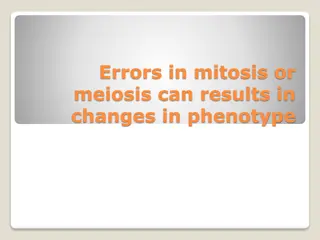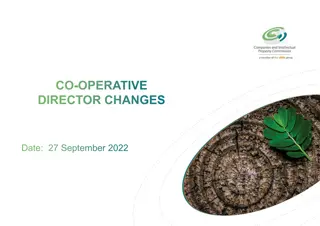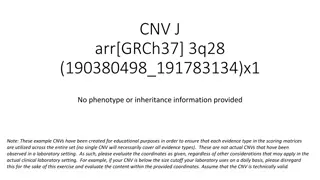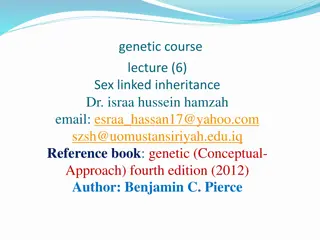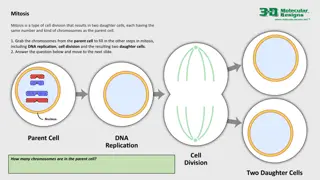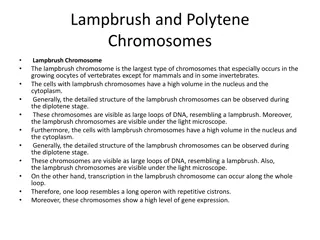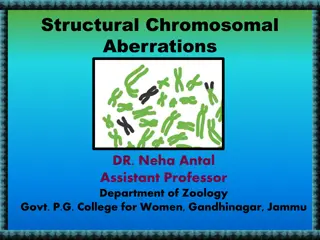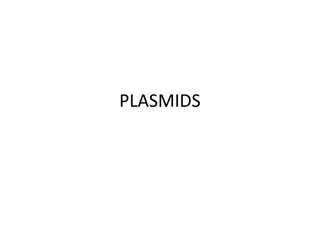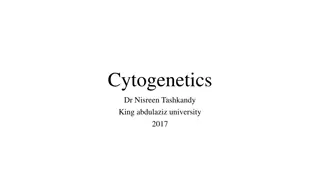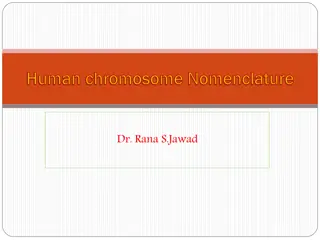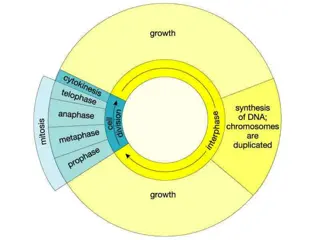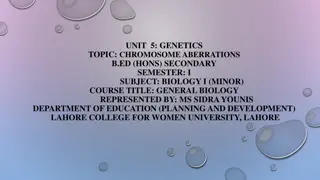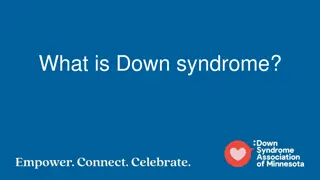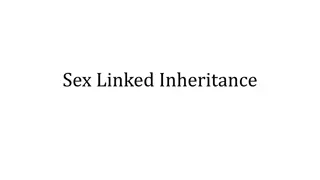Alterations in Chromosome Number: Euploid, Polyploid, Aneuploid
Different alterations in chromosome number including euploid, polyploid, and aneuploid conditions. Understand the causes and consequences of nondisjunction, trisomy, and monosomy. Learn about Down Syndrome, Edwards Syndrome, and their characteristics. Discover the impact of chromosomal abnormalities on human health and development.
Download Presentation

Please find below an Image/Link to download the presentation.
The content on the website is provided AS IS for your information and personal use only. It may not be sold, licensed, or shared on other websites without obtaining consent from the author.If you encounter any issues during the download, it is possible that the publisher has removed the file from their server.
You are allowed to download the files provided on this website for personal or commercial use, subject to the condition that they are used lawfully. All files are the property of their respective owners.
The content on the website is provided AS IS for your information and personal use only. It may not be sold, licensed, or shared on other websites without obtaining consent from the author.
E N D
Presentation Transcript
Alterations in Chromosome Number Euploid Have the normal chromosome number Polyploid A cell with extra sets of chromosomes Ex: triploid (3n) Aneuploid Cells missing a single chromosome or having an extra chromosome
Alterations in Chromosome Number Nondisjunction: occurs when either Homologs fail to separate during anaphase I of meiosis Sister chromatids fail to separate during anaphase II Result: one gamete has 2 copies of one chromosome and the other has no copy of that chromosome
Alterations in Chromosome Number If either of these gametes unites with another during fertilization, the result is aneuploidy (abnormal chromosome number). Trisomy: extra chromosome (more common) Monosomy: missing a chromosome
Alterations in Chromosome Number Frequency of nondisjunction is quite high in humans, but the results are usually so devastating to the zygote that miscarriage occurs very early in the pregnancy. If the individual survives, he or she usually has a set of symptoms (a syndrome) caused by the abnormal dose of each gene product from that chromosome.
Down Syndrome Nondisjunction of autosome Trisomy 21 Characteristic facial features, short stature, floppy appearance, developmental milestones come slowly, heart & kidney defects, hearing & visual loss, suppressed immune system, greater chance of developing leukemia & Alzheimer disease Most common autosomal aneuploid among liveborns Likelihood increases with age of the mother Average life expectancy is now 60 (in 1910 it was 9) Genome editing to shut off one X chromosome
Edwards Syndrome Nondisjunction of autosome Trisomy 18 Great physical & intellectual disabilities, almost every organ system affected: heart defects, displaced liver, growth retardation, oddly clenched fists, overlapping fingers, narrow flat skull, low-set ears, small mouth, unusual fingerprints, rocker-bottom feet Most do not survive to be born; children with full trisomy 18 generally do not live more than a few months
Patau Syndrome Nondisjunction of autosome Trisomy 13 Fusion of the developing eyes; heart, kidney, brain, face, & limb abnormalities; cleft lip/palate; small head; extra fingers/toes; extra spleen; atypical liver; rotated intestines; abnormal pancreas A few have survived to adulthood, but most rarely live more than a few months Do not progress developmentally beyond the 6- month level
Klinefelter Syndrome Nondisjunction of sex chromosomes 47XXY (extra X chromosome) Male sex organs; but underdeveloped sexually (small testes and prostate gland, sparse pubic & facial hair) Long arms & legs, large hands & feet, may develop breast tissue About 1 in 500 males Most common genetic or chromosomal cause of male infertility
Trisomy X Nondisjunction of sex chromosomes 47XXX (extra X chromosome) Females; healthy and fertile; usually cannot be distinguished from normal female except by karyotype Only symptoms are tall stature and menstrual irregularities; tend to be less intelligent than siblings About 1 in every 1000 females All but one of the X chromosomes in inactivated
Turners Syndrome Nondisjunction of sex chromosomes Monosomy X (45XO): one X chromosome & no 2ndsex chromosome (some are missing only part of an X chromosome) Looks normal at birth, except puffy hands & feet Wide-set nipples, soft nails that turn up, slight webbing at the back of the neck, short, coarse facial features, low hairline at the back of the head, impaired hearing, ear infections At sexual maturity, sparse body hair, don t ovulate or menstruate, breasts don t develop, small uterus The only viable monosomy in humans Affects 1 in 2500 female births; 99% of XO fetuses are not born; life span is shortened slightly More likely to develop osteoporosis, diabetes, colon cancer
XXYY Syndrome Nondisjunction of sex chromosome XXYY (extra X chromosome & extra Y chromosome) More severe behavioral problems, tend to develop foot & leg ulcers from poor circulation Attention deficit disorder, obsessive compulsive disorder, autism, & learning disabilities typically develop by adolescence Low testosterone, delayed development of secondary sexual characteristics, undescended testes infertile About 1 in 17,000 newborn boys Until recently was diagnosed as Klinefelter s
XYY Males Nondisjunction of sex chromosomes 47XYY (extra Y chromosome) Very tall, acne 1 in 1000 males criminally aggressive hypothesis disproven over time; 96% not destined to become criminals






